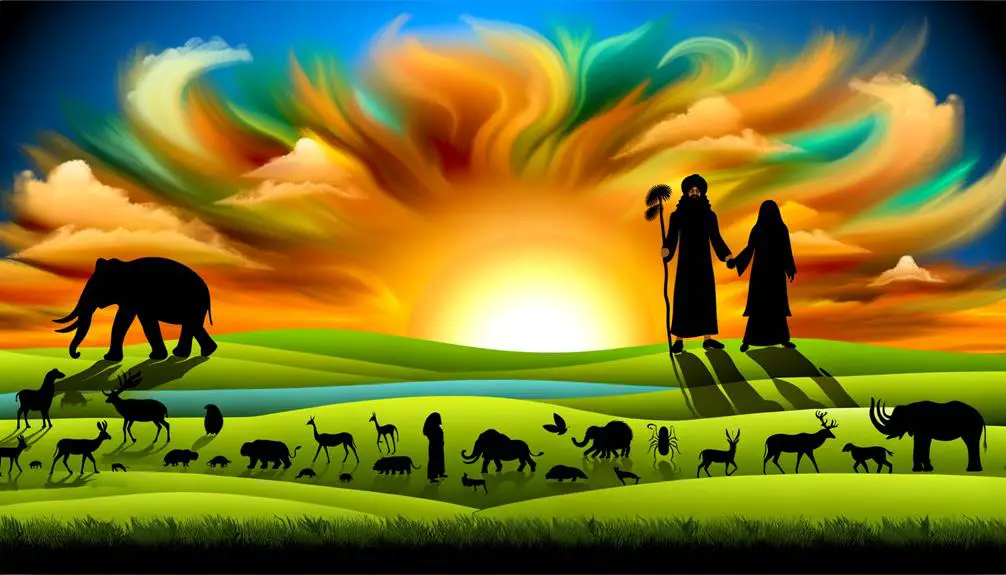Kickstart your journey through Genesis 1 with insights into creation's divine orchestration, and uncover the depths of its profound beginnings.

Bible Study – The Book of Genesis – Chapter 1 – Summary and Analysis
In Genesis Chapter 1, you explore the profound act of creation, where an omnipotent being transforms chaos into a meticulously organized universe. This chapter lays out a deliberate sequence: light and darkness, sky and waters, land and vegetation, celestial bodies, and finally, all forms of life. Each step reveals a divine intent to establish order and sustain life, with light serving as a metaphor for goodness. The narrative emphasizes the importance of human stewardship over creation, urging a harmonious relationship with Earth. Understanding this foundational chapter offers insights into the interconnected and intentional design of the world, hinting at deeper layers of meaning awaiting your exploration.
Key Takeaways
- Genesis 1 outlines the creation of the universe, emphasizing a deliberate act by an omnipotent being over six days.
- Days 1 to 4 focus on forming the cosmos and establishing light, sky, land, and celestial bodies, symbolizing order from chaos.
- Days 5 and 6 describe the creation of life, including plants, animals, and humans, highlighting diversity and interdependence.
- The chapter underscores the concept of divine intent and meticulous design in creation, setting a foundation for human stewardship of Earth.
- Genesis 1 concludes with the sanctification of the seventh day, emphasizing rest and reflection on creation's divine origin and purpose.
The Beginning of Creation

In the opening verses of Genesis Chapter 1, we're immediately introduced to the profound act of creation, where God methodically brings the universe into existence from a state of void and formlessness. This narrative isn't just a tale of origins; it's imbued with cosmic significance, revealing the divine intent behind creation. You're invited to explore deeply into the text, where each word and phrase is loaded with theological implications.
The phrase 'In the beginning' itself sets the stage for understanding the universe's origin as a deliberate act by an omnipotent being. It's not just about the initial start but also about establishing the universe's purpose and order. This introduction to creation serves as a foundation for the entire biblical narrative, highlighting God's sovereignty and the intentional design behind everything that exists.
The description of the earth as 'without form and void' and the presence of 'darkness over the surface of the deep' further underscores the transformation from chaos to order. It's important to grasp the magnitude of this change, which isn't just a physical act but a manifestation of divine will. The act of creation, as depicted here, is a deliberate process, guided by God's desire to shape a world that reflects His glory and order.
Day One: Light and Darkness
On the first day of creation, God commanded, 'Let there be light,' thereby distinguishing light from darkness and introducing the fundamental binary that underpins the cosmic order. This Divine command not only marks the inception of the physical universe but also sets a precedent for the role of divine will in shaping the cosmos. The separation of light from darkness is emblematic of the establishment of order from chaos, a motif that recurs throughout the biblical narrative and in various creation myths across cultures.
The act of naming the light 'Day' and the darkness 'Night' further emphasizes the importance of language and categorization in the creation process. It's through this divine taxonomy that the world's structure becomes intelligible to humanity. This initial act of separation and naming lays the foundation for the subsequent acts of creation, highlighting the methodical nature of the divine plan.
Analyzing this further, the light's creation before any physical sources of light (like the sun and the moon, which are created later) suggests that the light referred to on the first day symbolizes knowledge, understanding, and divine presence. This interpretation aligns with the view of light as a metaphor for goodness and truth, contrasting the darkness, often associated with ignorance and evil.
In this context, the narrative of the first day serves as an allegorical framework for understanding the cosmic order. It underscores the centrality of divine command in bringing forth light, both literal and metaphorical, into the world, setting the stage for all of creation that follows.
Day Two: Sky and Waters

Continuing the divine orchestration of creation, God next delineates the sky from the waters, establishing a firmament to separate the waters above from those below. This act is not merely a significant division but signifies a foundational aspect of Earth's structure, introducing the concept of atmospheric layers and the water cycle, pivotal for life.
This separation, termed 'firmament' or sky, is essential for understanding the Earth's atmospheric composition. The narrative subtly hints at the complexity of these layers, each playing a vital role in sustaining life through temperature regulation and protection from harmful solar radiation. Furthermore, the mention of 'waters above and below' alludes to the water cycle's early conception, illustrating an intricate system of precipitation, evaporation, and condensation, essential for maintaining ecosystems and human survival.
Aspect |
Significance |
|---|---|
Atmospheric Layers |
Provides a scaffold for weather patterns, climate regulation, and sustains aerial and terrestrial life. |
Water Cycle |
Ensures the continuous supply of fresh water, crucial for all known forms of life. |
Analyzing this segment through a scholarly lens reveals a profound understanding of Earth's environmental mechanics, articulated through the narrative of creation. It emphasizes the interdependence of sky and waters, a concept that resonates with modern scientific observations about the Earth's atmosphere and hydrological cycle. This narrative layer not only delineates a physical division but also underscores the balance and harmony inherent in the natural world, a testament to the meticulous design of creation.
Day Three: Land, Seas, and Vegetation
With the arrival of the third day, God initiated the formation of land and seas, carving out spaces for diverse ecosystems and heralding the advent of vegetation. This moment in Genesis signifies a critical juncture, where the Earth's barren state moves into one brimming with life, particularly through the introduction of plant diversity. This diversity isn't just a proof of the richness of creation but also sets the foundational principles for agricultural practices that humanity would later adopt.
You're invited to analyze the text from a perspective that sees the emergence of land and vegetation as a forerunner to the vast array of ecosystems we're familiar with today. The separation of land from the seas created niches for various species, but the mention of vegetation is particularly remarkable. It's the first instance where life, in its most basic form, is introduced, emphasizing not just survival but the beginning of ecological balance.
The agricultural implications are profound. Early verses pointing to God's command for the Earth to 'bring forth grass, the herb yielding seed, and the fruit tree yielding fruit' can be interpreted as the first nod towards sustainable practices. It suggests an ecosystem designed for self-renewal and sustenance, principles at the heart of modern agriculture.
Understanding this part of Genesis through an analytical lens reveals layers of meaning. It's not merely about the creation of physical spaces but the introduction of a system capable of supporting life. The emphasis on plant diversity underscores the importance of biodiversity for ecological health and agricultural sustainability, echoing through millennia to inform contemporary environmental and agricultural methodologies.
Day Four: Sun, Moon, and Stars

The fourth day marks a pivotal moment in Genesis, as God commands the creation of the sun, moon, and stars, fundamentally altering the Earth's relationship with light and time. This act not only illuminates the world but also establishes a framework for measuring time, seasons, days, and years. The celestial functions introduced on this day have profound astronomical significance, serving as a beacon for both the physical and metaphorical darkness.
Delving deeper, the placement of these celestial bodies reflects an intricate design intended to govern the night and day, distinguishing them in a rhythmic cycle that's essential for life as humanity understands it. The sun's dominance during the day and the moon and stars' guidance through the night underscore a harmonious balance in the universe, orchestrated by divine command. This duality between light and darkness isn't just literal but also symbolizes the omnipresence of divine order and wisdom.
Moreover, the astronomical significance of this event can't be overstated. These celestial bodies aren't merely sources of light but are pivotal for the gravitational balance within our solar system, influencing tides, climate, and biological cycles on Earth. This suggests that their creation wasn't only an act of providing light but also an intricate setup for the sustenance of life and the establishment of timekeeping markers for humanity.
In essence, day four's narrative in Genesis encapsulates a moment of divine intervention where the celestial functions were meticulously designed, imbuing the universe with order and purpose. This account, rich in symbolism and astronomical significance, invites reflection on the interconnectedness of creation and the intentional design behind the cosmos.
Day Five: Fish and Birds
On day five, God's creative command brought forth a teeming diversity of fish and birds, populating the waters and the skies with life. This phase in the Genesis account not only underscores the importance of divine creativity but also highlights the complexity and interdependence of life within aquatic habitats and avian migration patterns. The introduction of fish and birds marks a significant moment in the narrative, where attention shifts from celestial bodies to Earth's living inhabitants, emphasizing the sustenance and beauty they contribute to the world.
Analyzing the creation of fish, one can't help but marvel at the intricate ecosystems within aquatic habitats. These environments, teeming with a plethora of species, showcase the meticulous design in the balance of marine life, from the smallest plankton to the largest whales. Each species plays a vital role in maintaining the health and equilibrium of their habitats, a proof of the thoughtful interconnectivity embedded in creation.
Similarly, the creation of birds introduces the concept of avian migration, a phenomenon that illustrates the complexity of God's design in animal behavior and ecology. Birds, equipped with the innate ability to navigate vast distances across continents, exemplify the intricate programming within living creatures to adapt, survive, and thrive. This aspect of creation speaks volumes about the dynamic nature of life on Earth, where movement and migration are essential for the balance of ecosystems.
Through the lens of day five, one gains a deeper appreciation for the diversity and sophistication of life on Earth. The narrative invites readers to ponder the interconnectedness of all living beings and the divine foresight in crafting such an elaborate and harmonious natural world.
Day Six: Land Animals and Humans

Continuing the narrative of creation, day six introduces the formation of land animals and humans, marking a significant advancement in the complexity and stewardship of life on Earth. This phase in the Genesis account not only showcases the diversity of life but also sets the stage for a profound discussion on the ethical implications of human dominion over animals and the natural world. As you explore further into the text, it's evident that this isn't merely about the chronological ordering of creation; it's a foundational moment that establishes humans as stewards of the Earth.
The creation of land animals precedes that of humans, suggesting a deliberate order in the unfolding of life that emphasizes the interconnectedness of all species. This sequence invites you to contemplate the responsibility that comes with such dominion, hinting at the necessity for environmental stewardship. The text implicitly argues that with great power comes great responsibility, urging a reflection on how humanity interacts with and impacts the natural world.
The ethical implications of this narrative are significant. It challenges you to ponder the balance between utilizing natural resources for human benefit and preserving the integrity of creation. This equilibrium is vital in discussions on sustainability and environmental ethics, where the Genesis account serves as an early framework for examining our role and impact on the planet.
Reflections on Genesis Chapter 1
Reflecting on Genesis Chapter 1 invites you to explore the profound implications of creation, examining how this narrative sets a foundational framework for understanding humanity's relationship and stewardship over the Earth. The story reveals a tapestry of divine intent, where each element of creation is meticulously designed with purpose and interconnectivity. As you dig deeper, you'll recognize that human stewardship isn't merely suggested, but intricately woven into the fabric of this narrative.
The concept of Divine intent in Genesis Chapter 1 goes beyond the mere act of creation; it speaks to an intentional design where humans are entrusted with the stewardship of the Earth. This stewardship implies a responsibility that transcends exploitation, urging a harmonious relationship with all of creation. The narrative positions humans as caretakers, a role that demands wisdom, respect, and a profound understanding of the balance within the natural world.
Analyzing this chapter, you're encouraged to ponder the implications of human stewardship in contemporary times. How has humanity measured up to this divine mandate? The text challenges you to reflect on the ways in which society has fostered or faltered in its duty to preserve and protect the environment. It beckons a deeper inquiry into how modern practices align or deviate from the initial blueprint of stewardship outlined in Genesis.
Ultimately, Genesis Chapter 1 serves as a timeless reminder of the sacred trust between humanity and the Earth. It calls for a conscientious reflection on how to uphold this divine mandate, ensuring that stewardship remains a guiding principle in the ongoing narrative of creation.
Frequently Asked Questions
How Does the Interpretation of Genesis 1 Vary Among Different Religions and Denominations?
Different religions and denominations interpret Genesis 1 through varied lenses, focusing on cosmological symbols and ritual practices. You'll find divergent views on creation, reflecting deep theological debates and shaping distinct spiritual and scholarly perspectives.
What Are the Scientific Arguments Related to the Creation Story in Genesis 1, and How Do They Compare to the Biblical Narrative?
You're diving into the cosmic soup, where quantum fluctuations and the cosmic microwave background challenge the Genesis narrative. Analyzing this, you find science and scripture in a thrilling, scholarly tug-of-war over creation's origins.
How Has the Understanding of Genesis Chapter 1 Evolved Over Time, and What Historical Events Have Influenced Its Interpretation?
Your understanding of Genesis 1 has shifted through cultural symbolism and linguistic evolution. Historical events have deeply influenced its interpretation, leading to a nuanced, scholarly analysis that reflects changing perspectives and analytical depth over time.
In What Ways Have Artists, Musicians, and Filmmakers Been Inspired by Genesis 1 to Create Works of Art, Music, and Cinema?
Artists, musicians, and filmmakers have explored Genesis 1's themes into their work, using creative symbolism and theological imagery to investigate creation's mysteries. They've delved deep, offering fresh perspectives on ancient narratives through their art.
How Does Genesis 1 Address the Concept of Stewardship of the Earth, and What Implications Does This Have for Contemporary Environmental Ethics?
Genesis 1 promotes stewardship, urging you to care for Earth through green theology and ecological spirituality. This implies you should adopt sustainable practices, influencing contemporary environmental ethics by advocating for responsible, ethical treatment of nature.
Conclusion
In summing up Genesis Chapter 1, you've traversed the tale of time's dawn, witnessing the world woven from void to vibrancy. From the celestial spheres to the sea's sprawling species, each day delineates divine design, displaying a deliberate, detailed decree.
This narrative not only narrates nature's nascent stages but also invites introspection into humanity's hallowed heritage. Analyzing this ancient account affords us a profound perspective on purpose, presence, and our perpetual partnership with the planet.



Sign up